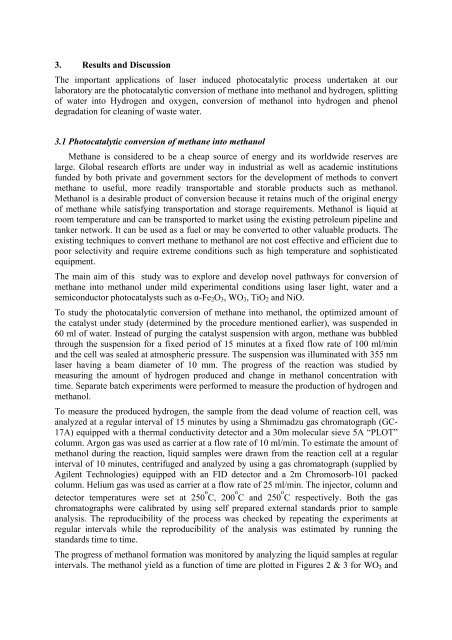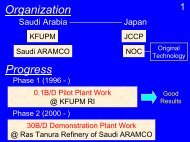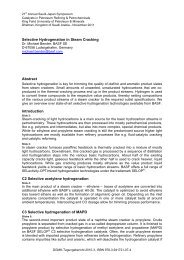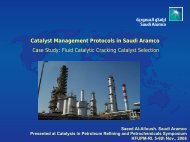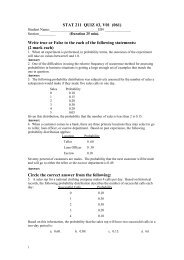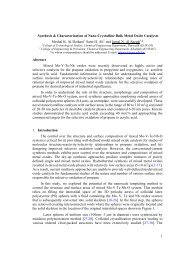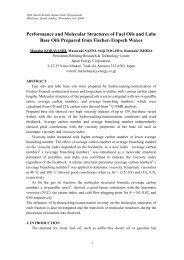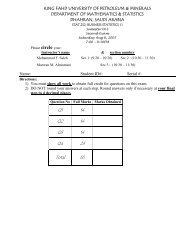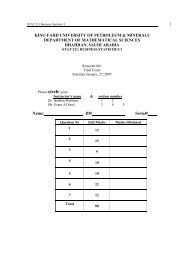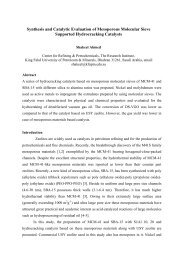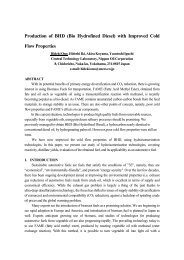Laser-Induced Photocatalysis and its Applications in Petrochemicals ...
Laser-Induced Photocatalysis and its Applications in Petrochemicals ...
Laser-Induced Photocatalysis and its Applications in Petrochemicals ...
You also want an ePaper? Increase the reach of your titles
YUMPU automatically turns print PDFs into web optimized ePapers that Google loves.
3. Results <strong>and</strong> DiscussionThe important applications of laser <strong>in</strong>duced photocatalytic process undertaken at ourlaboratory are the photocatalytic conversion of methane <strong>in</strong>to methanol <strong>and</strong> hydrogen, splitt<strong>in</strong>gof water <strong>in</strong>to Hydrogen <strong>and</strong> oxygen, conversion of methanol <strong>in</strong>to hydrogen <strong>and</strong> phenoldegradation for clean<strong>in</strong>g of waste water.3.1 Photocatalytic conversion of methane <strong>in</strong>to methanolMethane is considered to be a cheap source of energy <strong>and</strong> <strong>its</strong> worldwide reserves arelarge. Global research efforts are under way <strong>in</strong> <strong>in</strong>dustrial as well as academic <strong>in</strong>stitutionsfunded by both private <strong>and</strong> government sectors for the development of methods to convertmethane to useful, more readily transportable <strong>and</strong> storable products such as methanol.Methanol is a desirable product of conversion because it reta<strong>in</strong>s much of the orig<strong>in</strong>al energyof methane while satisfy<strong>in</strong>g transportation <strong>and</strong> storage requirements. Methanol is liquid atroom temperature <strong>and</strong> can be transported to market us<strong>in</strong>g the exist<strong>in</strong>g petroleum pipel<strong>in</strong>e <strong>and</strong>tanker network. It can be used as a fuel or may be converted to other valuable products. Theexist<strong>in</strong>g techniques to convert methane to methanol are not cost effective <strong>and</strong> efficient due topoor selectivity <strong>and</strong> require extreme conditions such as high temperature <strong>and</strong> sophisticatedequipment.The ma<strong>in</strong> aim of this study was to explore <strong>and</strong> develop novel pathways for conversion ofmethane <strong>in</strong>to methanol under mild experimental conditions us<strong>in</strong>g laser light, water <strong>and</strong> asemiconductor photocatalysts such as α-Fe 2 O 3 , WO 3 , TiO 2 <strong>and</strong> NiO.To study the photocatalytic conversion of methane <strong>in</strong>to methanol, the optimized amount ofthe catalyst under study (determ<strong>in</strong>ed by the procedure mentioned earlier), was suspended <strong>in</strong>60 ml of water. Instead of purg<strong>in</strong>g the catalyst suspension with argon, methane was bubbledthrough the suspension for a fixed period of 15 m<strong>in</strong>utes at a fixed flow rate of 100 ml/m<strong>in</strong><strong>and</strong> the cell was sealed at atmospheric pressure. The suspension was illum<strong>in</strong>ated with 355 nmlaser hav<strong>in</strong>g a beam diameter of 10 mm. The progress of the reaction was studied bymeasur<strong>in</strong>g the amount of hydrogen produced <strong>and</strong> change <strong>in</strong> methanol concentration withtime. Separate batch experiments were performed to measure the production of hydrogen <strong>and</strong>methanol.To measure the produced hydrogen, the sample from the dead volume of reaction cell, wasanalyzed at a regular <strong>in</strong>terval of 15 m<strong>in</strong>utes by us<strong>in</strong>g a Shmimadzu gas chromatograph (GC-17A) equipped with a thermal conductivity detector <strong>and</strong> a 30m molecular sieve 5A “PLOT”column. Argon gas was used as carrier at a flow rate of 10 ml/m<strong>in</strong>. To estimate the amount ofmethanol dur<strong>in</strong>g the reaction, liquid samples were drawn from the reaction cell at a regular<strong>in</strong>terval of 10 m<strong>in</strong>utes, centrifuged <strong>and</strong> analyzed by us<strong>in</strong>g a gas chromatograph (supplied byAgilent Technologies) equipped with an FID detector <strong>and</strong> a 2m Chromosorb-101 packedcolumn. Helium gas was used as carrier at a flow rate of 25 ml/m<strong>in</strong>. The <strong>in</strong>jector, column <strong>and</strong>detector temperatures were set at 250 o C, 200 o C <strong>and</strong> 250 o C respectively. Both the gaschromatographs were calibrated by us<strong>in</strong>g self prepared external st<strong>and</strong>ards prior to sampleanalysis. The reproducibility of the process was checked by repeat<strong>in</strong>g the experiments atregular <strong>in</strong>tervals while the reproducibility of the analysis was estimated by runn<strong>in</strong>g thest<strong>and</strong>ards time to time.The progress of methanol formation was monitored by analyz<strong>in</strong>g the liquid samples at regular<strong>in</strong>tervals. The methanol yield as a function of time are plotted <strong>in</strong> Figures 2 & 3 for WO 3 <strong>and</strong>


